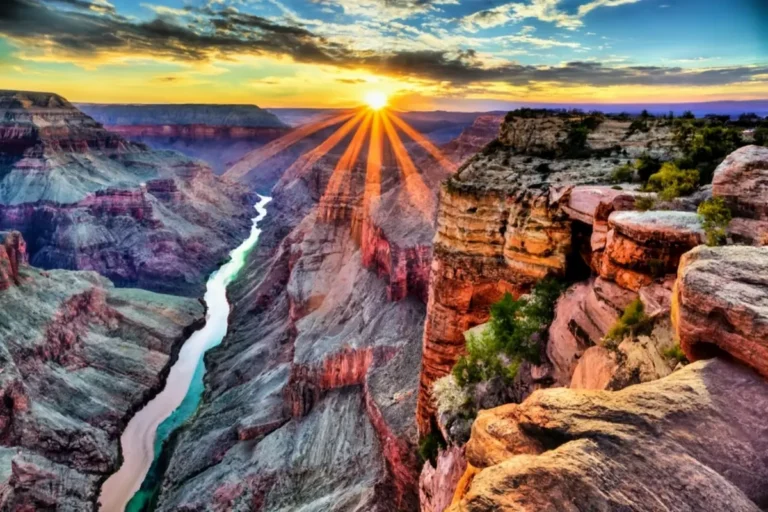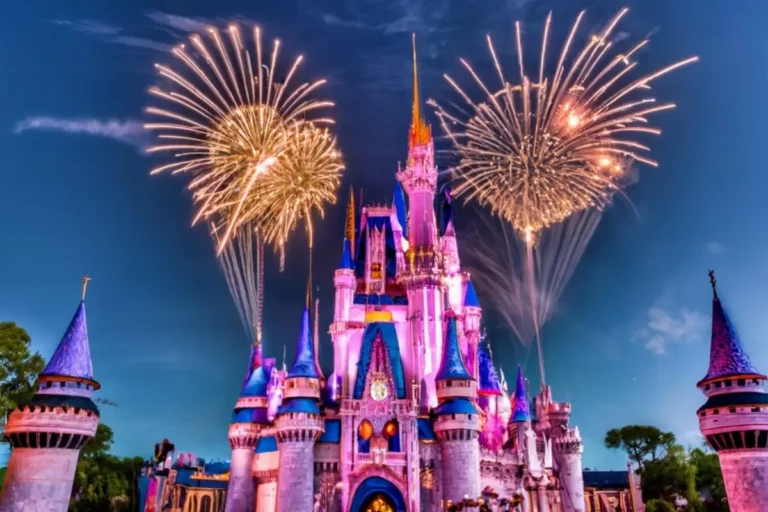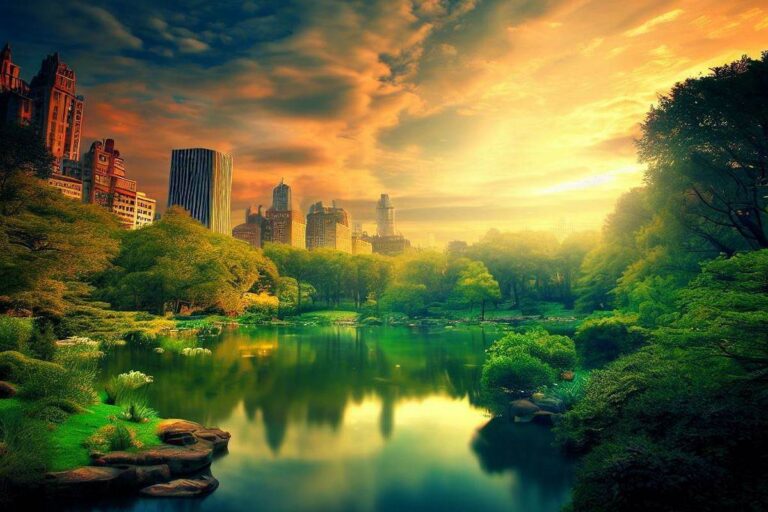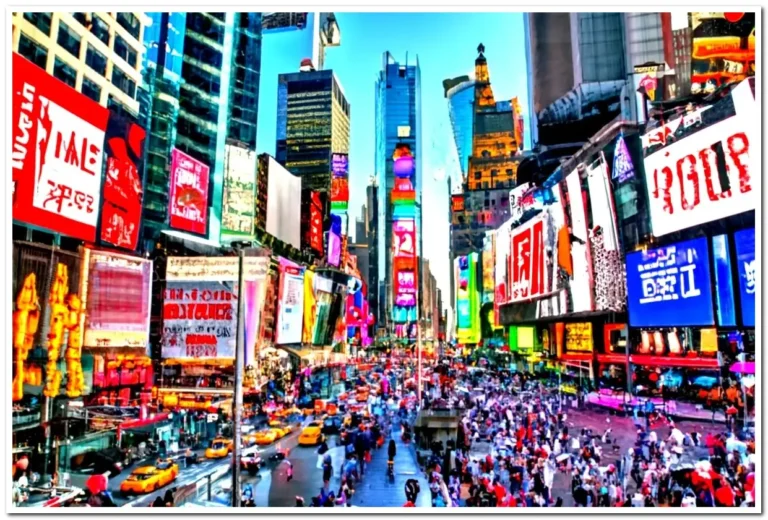Yellowstone Unveiled: 15 Burning Questions and Their Answers
Yellowstone: A Quick Glimpse into Nature’s Wonderland!
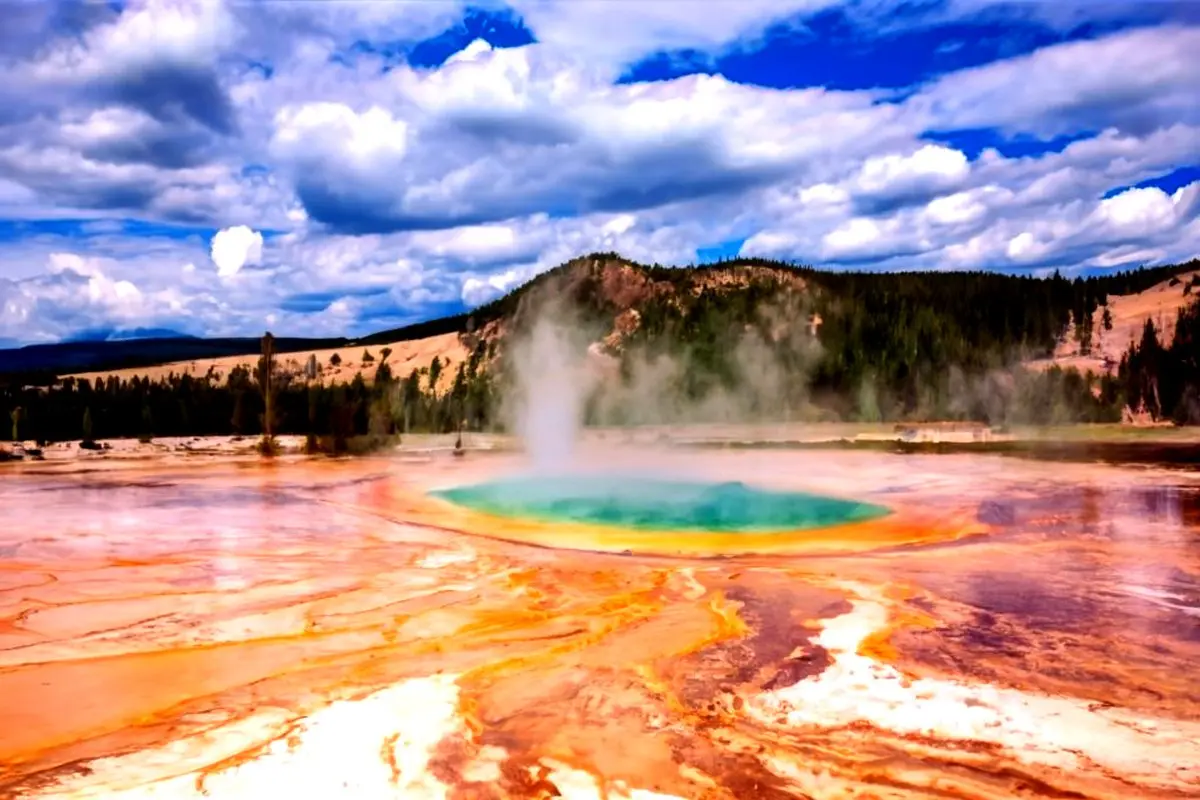
Table of Contents
Yellowstone was established in 1872 as the world’s first national park. It protects over 2 million acres of wilderness in Wyoming along with parts of Montana and Idaho.
This iconic park is truly a natural wonder, as it sits atop a massive super-volcano that fuels over 10,000 hydrothermal features. Among these are an impressive 500 geysers, which make up the majority of all on Earth. The sheer scale and power of this geological phenomenon is awe-inspiring, attracting visitors from all corners of the globe. The unique landscape and rare geothermal features create an otherworldly experience for those exploring this majestic park.
Famous sites like Old Faithful and the colorful Grand Prismatic Spring exemplify Yellowstone’s unique geology.
The park also provides vital habitat for bears, wolves, bison, elk and many other species.
Over 11,000 years before becoming a park, Native American tribes like the Shoshone inhabited the Yellowstone area.
Today visitors can explore the park’s natural wonders through activities like wildlife watching, hiking 900+ miles of trails, geyser gazing, and boating on Yellowstone Lake.
The peak visitation months are June through August, though lower crowds in spring and fall provide their own advantages.
Numerous lodging options like the Old Faithful Inn, Lake Yellowstone Hotel, cabins and campgrounds allow overnight stays in the park.
As the site of pioneering conservation efforts, Yellowstone continues as a global inspiration for environmental preservation today.
1. Why is Yellowstone National Park called the world’s first national park?

As you plan your trip to Yellowstone, it helps to understand its pioneering history and significance. Yellowstone was designated the world’s first national park back in 1872, protecting over 2 million acres of pristine wilderness for the benefit of all.
Yellowstone National Park is called the world’s first national park because it was the first area in the world designated for protection and enjoyment by the federal government. In 1872, President Ulysses S. Grant signed the Yellowstone National Park Protection Act, establishing Yellowstone as the first national park in not only the United States but the entire world.
This groundbreaking idea came from exploring and documenting the stunning volcanic and geothermal features in the Yellowstone region. The park preserves over 2 million acres of wilderness, full of geysers, hot springs, waterfalls, canyons, lakes, and wildlife. Yellowstone demonstrated the value of setting aside public lands for protection rather than private profit.
The term “national park” was a new concept in 1872. Giving federal protection to a large landscape had never been done before. But after Yellowstone’s designation, the national park idea spread globally. Canada established Banff National Park in 1885, Australia founded Royal National Park in 1879, and New Zealand set aside Tongariro National Park in 1887.
Today, Yellowstone National Park is widely considered the crown jewel of the US National Park Service. It remains one of the most popular national parks, receiving over 4 million visitors a year. Its status as the first national park highlights its forward-thinking protection of natural and cultural resources for the enjoyment of all.
2. What geological features make Yellowstone National Park so unique?

One reason Yellowstone has become such an iconic travel destination is its one-of-a-kind geology. The park contains half the world’s geysers, vivid hot springs, and evidence of the massive supervolcano lying just underground.
Yellowstone National Park contains an incredible collection of geological wonders that make it one of the most unique places on Earth. Here are some of the key geological features that set Yellowstone apart:
- The Yellowstone supervolcano – This giant volcano fuels the park’s amazing hydrothermal features. It last erupted 640,000 years ago but remains active.
- Geysers – Yellowstone has over 10,000 hydrothermal features, including about 500 geysers. This is over half of the world’s total geysers.
- Hot springs – Thousands of hot springs heat the park, including the world-famous Grand Prismatic Spring. Bacteria create stunning colors in the pools.
- Fumaroles – Yellowstone has over 10,000 fumaroles, openings that vent sulfurous steam into the air. Some are over 250°F (121°C)!
- Mud pots – Pools of bubbling mud created by the interacting hot water and volcanic clay. Famous ones include Fountain Paint Pot and Mud Volcano.
- Canyons – The Grand Canyon of Yellowstone with its waterfalls and vibrantly colored walls. Tower Fall and the Black Canyon of the Yellowstone.
- Lakes – Yellowstone Lake is North America’s largest high-elevation lake at 132 square miles. It has unique geological thermokarsts.
- Petrified forests – Fossilized redwood trees mark an ancient forest captured by volcanic deposits.
Yellowstone’s one-of-a-kind geology reveals the violent forces still shaping this region of North America and provides habitats for its unique wildlife.
3. When was Yellowstone National Park first established?

When packing for your Yellowstone adventure, it helps to know the park’s long history! Yellowstone National Park was first designated in 1872 to preserve its incredible natural features for future generations to enjoy.
Yellowstone National Park was first established as a national park on March 1, 1872, when President Ulysses S. Grant signed the Yellowstone National Park Protection Act. This landmark federal law set aside over 2 million acres of pristine wilderness in the Territories of Montana and Wyoming to create the world’s first national park.
While Native Americans had inhabited the Yellowstone region for over 11,000 years, organized exploration of the area by European Americans began in the early 1800s. Reports began circulating of the stunning geothermal features and spectacular geysers. The most famous early explorer was John Colter, who first documented the area in 1807-1808.
In 1870, an organized expedition was led by Henry Washburn and explored the Yellowstone area extensively. This helped raise awareness of the need to protect Yellowstone’s unique resources. The photographs and reports from this expedition helped convince U.S. Congress to establish Yellowstone as a national park.
The creation of Yellowstone National Park in 1872 laid the foundation for the future National Park Service. It began defining the mission to conserve lands and wildlife and provide for public enjoyment.
While Yellowstone was established as a public “pleasuring-ground,” early management was poor until the U.S. Army took over administration in 1886. Today, Yellowstone remains under the stewardship of the National Park Service, receiving millions of admiring visitors per year.
4. Where is Yellowstone National Park located?

As you make travel plans to experience Yellowstone’s wonders, it’s useful to know exactly where Yellowstone is situated! The vast majority of the park lies within the northwest corner of Wyoming.
Yellowstone National Park is located primarily in the northwest corner of Wyoming, extending into small portions of Montana and Idaho in the United States.
The park sits on top of the Yellowstone Caldera, which is the massive supervolcano responsible for the area’s geothermal activity. The majority of the 3,472 square miles that make up Yellowstone National Park are located in Wyoming.
Specifically, Yellowstone is situated where the Rocky Mountains meet the eastern edge of the Snake River Plain. The park has mountains exceeding 12,000 feet in elevation along its east and southeast boundaries. The lower elevations of the park’s forests are mainly in the northwest corner.
The closest major cities to Yellowstone National Park are:
- Bozeman, MT – 90 miles north
- Billings, MT – 129 miles northeast
- Idaho Falls, ID – 130 miles west
- Jackson, WY – 57 miles south
- Cody, WY – 52 miles east
- Livingston, MT – 53 miles north
There are 5 entrances into the park’s wilderness:
- North Entrance (Gardiner, MT)
- Northeast Entrance (Cooke City/Silver Gate, MT)
- East Entrance (Cody, WY)
- South Entrance (Grand Teton National Park)
- West Entrance (West Yellowstone, MT)
Yellowstone’s vast wilderness spans several wilderness ecosystems and provides habitats for numerous wildlife species. Its location places it within an active geologic zone still shaped by volcanic forces.
5. Why does Yellowstone have so many geysers and hot springs?

One key reason to visit Yellowstone is to witness its incredible collection of geysers and hot springs. The park actually contains over half of all the geysers on Earth!
Yellowstone National Park contains over 500 geysers and over 10,000 hydrothermal features due to its location above the Yellowstone supervolcano. This massive volcano provides the heat and geologic conditions that allow Yellowstone to contain over half the world’s geysers.
The direct source of Yellowstone’s heat is the magma chamber deep underground. This magma chamber is only 5-10 miles below the surface, fueling the park’s extreme geothermal activity. The magma heats up groundwater and creates convection currents that penetrate closer to the surface.
The filtration of hot groundwater also interacts with Yellowstone’s unique geology. Water percolates down through ancient rhyolite lava flows, becoming heated and picking up silica and minerals. As the heated water rises back up, the pressure drops and the silica precipitates out, forming the geyser cones and hot spring terraces.
The volcanic history of past eruptions also plays an important role. Glaciation and hydrothermal explosions have created deep reservoirs, cracks, and porous rock layers for the water to penetrate. Eruptions have also left silica deposits and heat flow patterns that influence Yellowstone’s hydrology.
In essence, the combination of abundant heat, water, and ideal geology leads to Yellowstone’s proliferation of geysers, hot springs, mud pots, and fumaroles. The hydrothermal features showcase the power of the underground volcanic system that makes Yellowstone such a globally significant geological wonder.
6. What types of wildlife call Yellowstone National Park home?

A main highlight of any trip to Yellowstone is spotting iconic wildlife like bears, wolves, bison, and elk in their natural habitats. The park provides a protected sanctuary for these and many other species.

Yellowstone National Park provides important intact habitat for a wide variety of wildlife species:
Mammals:
- Grizzly bears
- Black bears
- Gray wolves
- Bison
- Elk
- Moose
- Bighorn sheep
- Mountain goats
- Pronghorn
- Coyotes
- Beavers
- Otters
- Badgers
Birds:
- Bald eagles
- Golden eagles
- Osprey
- Trumpeter swans
- Great grey owls
- Sandhill cranes
- Peregrine falcons
- Rufous hummingbirds
Reptiles:
- Prairie rattlesnakes
- Bull snakes
- Yellow-bellied racer
Amphibians:
- Boreal chorus frogs
- Columbia spotted frogs
- Western toad
Fish:
- Cutthroat trout
- Arctic Grayling
- Mountain whitefish
This diversity of wildlife depends on Yellowstone’s ecosystems including forests, mountains, grasslands, rivers, and geothermal areas. Protecting this intact habitat allows these species to thrive while also providing incredible viewing opportunities for visitors.
7. When do most visitors come to Yellowstone National Park?

As you plan when to visit Yellowstone, it’s good to know the peak visitation seasons. The summer months of June through August are the most popular times to experience Yellowstone’s wonders.
Yellowstone National Park receives the highest number of visitors during the summer months of June, July, and August. This season offers the most accessible and comfortable weather for enjoying Yellowstone’s attractions.
Springtime in May and early June is the second most popular season. Wildflowers bloom and baby animals are born as the park transitions into summer. However, some roads and services are still closed.
Visits drop off significantly in the fall months of September and October as the weather cools and snow begins accumulating in the mountains. But fall offers beautiful foliage and fewer crowds.
Winter is the quietest season in Yellowstone, with significant snowfall and limited accessibility. However, for adventurous travelers, winter provides unique experiences like snow coach tours, cross-country skiing, and watching steam rising from the geysers across the frozen landscapes.
Here is a breakdown of the average number of recreation visits each month:
- January – 83,000 visits
- February – 95,000 visits
- March – 108,000 visits
- April – 169,000 visits
- May – 344,000 visits
- June – 681,000 visits
- July – 897,000 visits
- August – 881,000 visits
- September – 568,000 visits
- October – 268,000 visits
- November – 90,000 visits
- December – 84,000 visits
Planning a visit during the peak summer ensures the most amenities and activities. But traveling in the shoulder seasons provides more solitude to experience Yellowstone’s natural splendor.
8. Where are the best places to see wildlife in Yellowstone?

To maximize your chances of wildlife sightings in Yellowstone, head to habitats like Hayden Valley, Lamar Valley, and Yellowstone Lake, which offer prime viewing opportunities.
Here are some of the best places to spot iconic wildlife in Yellowstone National Park:
- Hayden Valley – This broad valley along the Yellowstone River hosts bison, elk, wolves, bears, trumpeter swans, and other wildlife. It is one of the park’s premier wildlife viewing destinations.
- Lamar Valley – Nicknamed “America’s Serengeti,” this northern area near the Lamar River provides vast open views where bison, pronghorn, bears, and wolves roam. Early morning and dusk are prime viewing times.
- Yellowstone Lake – This huge lake hosts an abundance of birds including bald eagles, osprey, pelicans, and trumpeter swans. Grizzly bears and other animals frequent the lakeshore.
- Madison River – Cutthroat trout jumping in the river attracts grizzlies and bald eagles. Bison and elk also graze along the waterway.
- Geothermal areas – Elk, bison, bears, and birds all frequent the hot springs and geysers to soak in the warm waters. Some of the best are Norris Geyser Basin and Grand Prismatic Spring.
- Yellowstone River – Follow the river north or south of Lake Village to potentially spot wolf packs, along with grizzlies, moose, and waterfowl.
Yellowstone’s diversity of habitat offers prime wildlife viewing opportunities year-round. Stopping frequently and carrying binoculars or spotting scopes will improve your chances of sighting different species.
9. Which are the most famous geysers and hot springs in Yellowstone?

Don’t miss Yellowstone’s star hydrothermal attractions like Old Faithful, Grand Prismatic Spring, and the Mammoth Hot Springs terraces as you explore the park’s geothermal wonders.
Yellowstone has over 10,000 hydrothermal features, but some of the most famous geysers and hot springs stand out:
- Old Faithful – The most famous geyser erupts around every 90 minutes up to 180 feet high. Its frequent eruptions draw huge crowds.
- Grand Geyser – Only erupting every 6-15 hours, Grand is the tallest predictable geyser, blasting water 180-200 feet into the air.
- Great Fountain Geyser – Active 4-15 times per day, Great Fountain ejects colorful bursts up to 150 feet high.
- Beehive Geyser – Its 4-8 daily eruptions blast an angled 200 foot stream that sounds like a jet engine.
- Lion Geyser – One of the most vigorous geysers erupts every hour or so about 90 feet straight up.
- Grand Prismatic Spring – The park’s largest hot spring displays stunning rings of color caused by heat-loving bacteria.
- Midway Geyser Basin – This whole basin contains brilliantly colored pools like the Excelsior and Opal Geyser springs.
- Mammoth Hot Springs – Elaborate and constantly changing white limestone terraces created by the travertine deposition.
- Steamboat Geyser – The world’s tallest active geyser has erupted over 300 feet high, but with no predictable intervals.
Visiting Yellowstone’s famous hydrothermal features provides a glimpse into the volcanic forces at work beneath the surface and displays nature’s vibrant colors.
10. How did the Yellowstone super-volcano form?

Understanding the volcanic origins of Yellowstone’s geysers will help you appreciate these features even more. The processes that formed the massive underground supervolcano created the park’s unique hydrothermal systems.
The Yellowstone supervolcano formed through a combination of processes including the movement of continental plates over one of Earth’s mantle hot spots. The hot spot interaction built up the massive magma chamber that fuels Yellowstone’s hydrothermal features and supervolcanic potential.
The story begins around 30 million years ago when the North American tectonic plate started drifting southwest over a hot plume of magma in the Earth’s mantle. The hot spot melted through the continental crust, building up pressure that led to huge lava eruptions onto the surface about 2.1 million years ago.
These massive eruptions covered over 5,000 square miles of land and formed the first of three calderas – giant craters from the volcanic collapses. The caldera-forming eruptions happened about 2.1 million, 1.3 million, and 640,000 years ago.
This left behind the 45 x 30 mile Yellowstone Caldera and the partially molten magma chamber that still exists 3-8 miles underground today. The magma chamber is approximately 34-45 miles wide and contains tens of thousands of cubic kilometers of molten rock.
The past eruptions deposited thick and widespread layers of volcanic material including rhyolite lava flows and ash. This left an unstable and fractured landscape above the remaining magma. The overlying hydrothermal system transports heat up from the magma fueling Yellowstone’s geysers.
The Yellowstone hot spot interaction continues today as the North American Plate drifts about 1-2 inches per year. This process formed the Yellowstone supervolcano and still powers its world-renowned geothermal features.
11. What are some of the key attractions for visitors in Yellowstone?

Make sure to see top Yellowstone attractions like the iconic geysers, the Grand Canyon of Yellowstone, abundant wildlife, and the scenic Yellowstone Lake on your trip to experience the park’s full grandeur.
Yellowstone National Park contains an astounding collection of natural and geologic attractions drawing over 4 million visitors per year. Here are some of the key features and sites visitors aim to explore:
- Old Faithful & Upper Geyser Basin – Yellowstone’s most famous geyser erupts regularly along with hundreds of other hydrothermal features.
- Grand Canyon of Yellowstone – Towering canyon walls and waterfalls like the Lower Falls plummeting 308 feet.
- Mammoth Hot Springs – Dramatic and constantly changing white, orange, and pink terraces created by the travertine limestone.
- Yellowstone Lake – With over 100 miles of shoreline, the huge lake offers scenic vistas, along with fishing and wildlife viewing.
- Wildlife watching – Iconic species like bison, bears, elk, and wolves thrive in Yellowstone’s intact ecosystems.
- Hiking trails – Over 900 miles of trails allow experiencing Yellowstone’s diverse landscapes and features on foot.
- Driving tours – The figure eight Grand Loop Road with overlooks guides visitors through Yellowstone’s main attractions.
- Geyser basins – Incredible concentrations of hot springs, mud pots, fumaroles, and steam vents across the park.
- Boating/Fishing – Anglers can cast for trout, while boat tours cruise Yellowstone Lake for scenery.
- Yellowstone’s history & heritage – Museums and historic structures illuminate the park’s native, pioneer, and conservation stories.
With so much natural diversity across its 3,472 square miles, Yellowstone offers incredible sights and experiences for visitors of all interests. From witnessing the explosive power of geysers to quietly watching wildlife in lush meadows, Yellowstone provides endless opportunities to appreciate its wilderness. Taking the time to explore different areas of the park allows visitors to gain a comprehensive understanding of what makes Yellowstone so special.
12. Who were the native peoples that originally inhabited Yellowstone?

Learning about Yellowstone’s original Native American inhabitants gives important cultural context to your travels here. Tribes like the Shoshone and Crow lived in and revered Yellowstone for over 11,000 years.
For thousands of years, before Yellowstone National Park was established, it was inhabited, used, and revered by various Native American tribes. The park contains over 1,000 archeological sites showing evidence of long human occupation.
The first people arrived in the Yellowstone region over 11,000 years ago at the end of the last Ice Age. These Paleoindian groups were nomadic hunter-gatherers spreading across the Americas. Useful obsidian from Yellowstone was traded across tribal territories.
Later peoples including the Shoshone, Bannock, Blackfeet, Crow, Flathead, and Nez Perce tribes had seasonal or permanent settlements around the park’s boundaries and made extensive use of its resources. Yellowstone was a sacred place featured in legends.
Native Americans hunted and fished across the Yellowstone Plateau, harvested obsidian, collected medicinal plants, and quarried rhyolite for making tools. The park’s thermal areas held spiritual significance as places for prayer and visions.
In the 19th century, conflicts arose as European Americans began entering the Yellowstone area more extensively. The Native American tribes were eventually displaced from their ancestral Yellowstone homelands through force, treaties, or agreements.
Today, the 26 tribes affiliated with the park maintain their cultural links to Yellowstone through oral histories, ceremonies, and returning to sacred sites. Understanding this long legacy of Native American stewardship is an important part of appreciating Yellowstone’s heritage.
13. Why is Yellowstone prone to forest fires?

Discover how Yellowstone’s ecology has adapted to benefit from periodic fires as part of the natural cycle. This will help you understand any burned areas you may encounter on your visit.
Yellowstone National Park is prone to periodic major forest fires due to a combination of its forest types, climate patterns, frequent lightning strikes, and past fire suppression practices.
Much of Yellowstone is covered in dense lodgepole pine forests. Lodgepole pines have serotinous cones that only open and release their seeds when exposed to high heat – the perfect adaptation for forest fire areas. Frequent historic fires helped lodgepole pines dominate.
The park also lies in an area where seasonal weather shifts drastically from very wet springs to hot, dry summers. This pattern allows ample vegetation growth to later dry out and become fuel. Yellowstone averages over 1,000 lightning strikes per year, which often ignites fires.
For many decades, the National Park Service suppressed most fires as soon as possible. But this caused fuel buildup. In 1988, over 250 fires burned 36% of the park, finally allowing fire to play its ecological role.
Today, managers allow more natural and prescribed burns to clear excess fuel and improve wildlife habitat. But with climate change lengthening fire seasons, Yellowstone will still see periodic massive blazes. Fire and lodgepole forests are intrinsically linked here, demonstrating fire’s natural role in Western ecosystems.
14. How can visitors safely enjoy the thermal features in Yellowstone?

As you admire Yellowstone’s hot springs and geysers, make sure to heed safety advice like staying on marked trails and keeping your distance from all thermal waters.
Yellowstone contains around 10,000 amazing thermal features, but visitors must follow safe practices to avoid injuries from scalding waters and thin crust. Here are some tips for safely enjoying geysers, hot springs, and steam vents:
- Stay on designated trails and walkways. Do not step on thermal areas or debris near features. Ground crust can be dangerously thin in many spots.
- Keep a safe distance from all features. Do not approach closer than safety railings or rope boundaries around hot springs and geysers.
- Do not touch thermal waters. Water temperatures often exceed the safe threshold for bathing and can cause severe or fatal burns.
- Avoid geyser and steam vent runoff channels. These are often boiling or acidic and prone to suddenly being inundated with scalding water.
- Watch children closely. Do not let kids run near thermal areas or put hands/feet in runoff water that appears tepid.
- Follow all park signage and warnings. Alerts about extreme danger areas are posted for visitor safety.
- Avoid burns from spray. Stand upwind of geysers when erupting to prevent hot steam or water from blowing onto you.
- Be alert around bison and other wildlife that frequent thermal areas. Give them plenty of space.
By using common sense and exercising caution around Yellowstone’s incredible hydrothermal features, visitors can marvel at their beauty while staying safe from any potential hazards.
15. Which lodging options are available inside Yellowstone National Park?

Choose from rustic lodges, modern hotels, cozy cabins, and campgrounds when booking overnight stays to experience Yellowstone’s natural splendor right from your accommodation.
Yellowstone National Park offers a variety of rustic and historic lodging options for overnight stays directly inside the park. Popular in-park lodges include:
- Old Faithful Inn – Historic log lodge near Old Faithful Geyser with common areas showcasing log construction.
- Lake Yellowstone Hotel – Elegant Colonial Revival hotel overlooking Yellowstone Lake and offering lake views.
- Lake Lodge Cabins – Rustic 1920s cabins adjacent to Lake Yellowstone Hotel and the lake shoreline.
- Canyon Lodge and Cabins – Modern or frontier-style lodge rooms and cabins in the canyon area.
- Mammoth Hot Springs Hotel and Cabins – Historic hotel buildings and updated cabins at the park’s northwestern base.
- Roosevelt Lodge Cabins – Simple rustic cabins with an Old West theme near Tower Fall in the Tower-Roosevelt area.
- Grant Village – Modern hotel along the shore of Yellowstone Lake in the Grant Village area.
- Old Faithful Snow Lodge – Winter-only snow lodge providing warm rooms near Old Faithful during colder months.
In addition, Yellowstone has hundreds of campsites for tents, RVs, and cabins at 12 campgrounds around the park. Reservations for park lodging are recommended 6-12 months in advance of travel.
Key Takeaways
Some key takeaways from this overview of Yellowstone National Park:
- Unique geology – Yellowstone contains an incredible concentration of geysers, hot springs, and other hydrothermal features fueled by its supervolcano.
- Early protection – Yellowstone was the world’s first national park, established in 1872 to preserve its natural wonders.
- Abundant wildlife – The park provides intact habitat for grizzlies, wolves, bison, elk, and many other species.
- Native American history – Native tribes like the Shoshone and Crow inhabited this sacred landscape for over 11,000 years before being displaced.
- Visitor attractions – Famous sites like Old Faithful, the Grand Canyon of Yellowstone, and Yellowstone Lake draw over 4 million annual visitors.
- Recreation – The park offers hiking, fishing, wildlife viewing, geyser gazing, and many other activities across its vast wilderness.
- Lodging choices – Historic lodges, modern hotels, rustic cabins, and campgrounds provide overnight options in the park.
- Need to preserve – As the world’s first park, Yellowstone continues to inspire conservation and ecological stewardship worldwide.
Conclusion

In conclusion, Yellowstone National Park remains one of the most remarkable protected areas on Earth. Its plethora of geysers, hot springs, and fumaroles sitting atop an active supervolcano showcase the powerful geologic forces still shaping this region.
Preserved ecosystems from alpine forests to grassy valleys allow iconic wildlife to thrive. As the site of pioneering conservation over 150 years ago, Yellowstone continues to inspire appreciation and stewardship of the natural world across the globe today.
Visiting Yellowstone offers the chance to marvel at its amazing hydrothermal features, observe diverse wildlife, and reflect on humans’ complex relationship with the wild.

